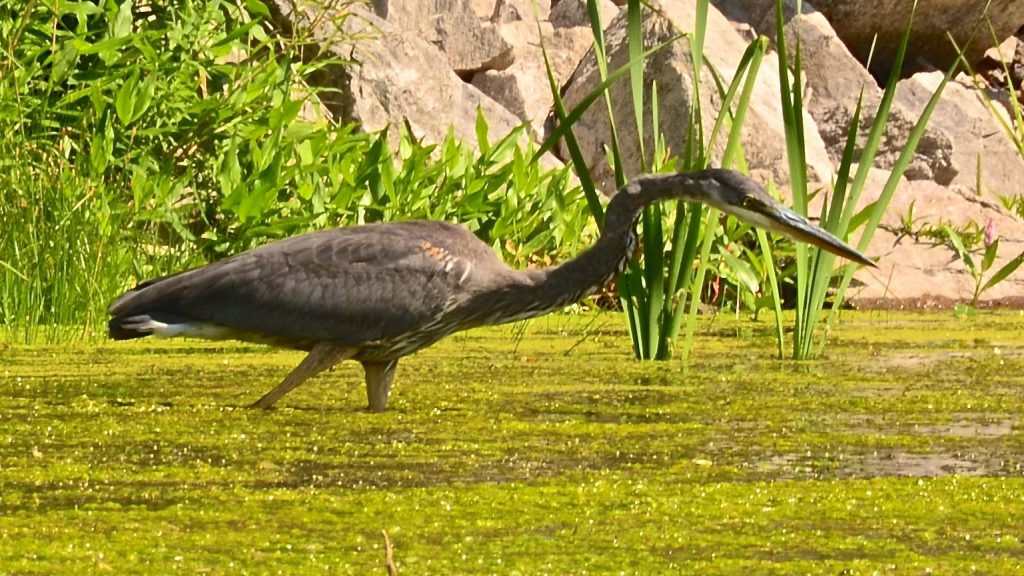We see the Great Blue Heron on Montana’s Missouri River corridor nearly daily. They do not go too long without a meal on this 4 season river. I’ve seen them get many fish. Juvenilles, teens, and a few adults. Once, a snake. Yep. They dig the reptiles.
Much of this information come from the cool site All About Birds Great Blue Heron. Check it here if you want even more information about the GBH.
Cool Blue Heron Facts
- Thanks to specially shaped neck vertebrae, Great Blue Herons can curl their neck into an S shape for a more aerodynamic flight profile and to quickly strike prey at a distance.
- Great Blue Herons have specialized feathers on their chest that continually grow and fray. The herons comb this “powder down” with a fringed claw on their middle toes, using the down like a washcloth to remove fish slime and other oils from their feathers as they preen. Applying the powder to their underparts protects their feathers against the slime and oils of swamps.
- Great Blue Herons can hunt day and night thanks to a high percentage of rod-type photoreceptors in their eyes that improve their night vision.
Despite their impressive size, Great Blue Herons weigh only 5 to 6 pounds thanks in part to their hollow bones—a feature all birds share. - Great Blue Herons in the northeastern U.S. and southern Canada have benefited from the recovery of beaver populations, which have created a patchwork of swamps and meadows well-suited to foraging and nesting.
- Along the Pacific coast, it’s not unusual to see a Great Blue Heron poised atop a floating bed of kelp waiting for a meal to swim by.
- The white form of the Great Blue Heron, known as the “great white heron,” is found nearly exclusively in shallow marine waters along the coast of very southern Florida, the Yucatan Peninsula, and in the Caribbean. Where the dark and white forms overlap in Florida, intermediate birds known as “Wurdemann’s herons” can be found. They have the body of a Great Blue Heron, but the white head and neck of the great white heron.
- The oldest Great Blue Heron, based on banding recovery, was 24 years old.
- Great Blue Herons congregate at fish hatcheries, creating potential problems for the fish farmers. A study found that herons ate mostly diseased fish that would have died shortly anyway. Sick fish spent more time near the surface of the water where they were more vulnerable to the herons.
Habitat
- Great Blue Herons live in both freshwater and saltwater habitats, and also forage in grasslands and agricultural fields, where they stalk frogs and mammals. Most breeding colonies are located within 2 to 4 miles of feeding areas, often in isolated swamps or on islands, and near lakes and ponds bordered by forests.
Food
Fish
- Great Blue Herons eat nearly anything within striking distance, including fish, amphibians, reptiles, small mammals, insects, and other birds. They grab smaller prey in their strong mandibles or use their dagger-like bills to impale larger fish, often shaking them to break or relax the sharp spines before gulping them down.
Nest Placement
- Great Blue Herons nest mainly in trees, but will also nest on the ground, on bushes, in mangroves, and on structures such as duck blinds, channel markers, or artificial nest platforms. Males arrive at the colony and settle on nest sites; from there, they court passing females. Colonies can consist of 500 or more individual nests, with multiple nests per tree built 100 or more feet off the ground.
Behavior
- Great Blue Herons forage, usually alone, across much of the U.S. This largest of the North American herons wades slowly or stands stock still, peering into the water for prey. In flight the Great Blue Heron folds it neck into an “S” shape and trails its long legs behind, dangling them as it prepares to land or when courting. Breeding birds nest in colonies that can number several hundred pairs, where they build stick nests in trees, on bushes, or on the ground. If you visit a colony, look for elaborate courtship and pair-bonding displays that include a ritualized greeting, stick transfers, and nest relief ceremony in which the birds erect their plumes and “clapper” their bill tips. Pairs are mostly monogamous during a season, but they choose new partners each year. Away from the colony, Great Blue Herons defend feeding territories from other herons with dramatic displays in which the birds approach intruders with their head thrown back, wings outstretched, and bill pointing skyward. Gulls and even humans may also be a target of this defensive maneuver.


6 Comments.
Thats cool stuff! Thanks for taking the time! My am coffee wouldn’t be the same without the reports!
Cool.
Great interesting column this morning. Thank you for taking the time to do the research and the writing. It gave me renewed interest in this wonderful bird.
As always love your bird posts, I am a birdie watcher and lover. We are also blessed with an amazing Blue Heron rookery on the lower river.
absolutely beautiful. I want a 16×20 print for Christmas. thanking you in advance. miss you so much.
I love it when I’m shore fishing the riprap for walleye, a heron will always stand close by and fish with me. They seem to come out of nowhere,hang out for awhile and then vanish.